PICOT Analysis: Antibiotics vs. Non-Antibiotics in Acute Otitis Media
VerifiedAdded on 2022/08/22
|11
|3174
|21
Essay
AI Summary
This essay presents a PICOT analysis focused on the treatment of acute otitis media (AOM) in children, a common ear infection. It explores the use of both antibiotic and non-antibiotic medications, addressing the ongoing debate within the medical community regarding the most effective approach. The paper defines the PICOT question, examining the population (children with AOM), intervention (antibiotics), comparison (antibiotics vs. non-antibiotics), outcome (efficiency in symptom relief), and time (duration of treatment). It discusses the prevalence of antibiotic use, the rationale behind it (bacterial involvement), and the effectiveness of medications like amoxicillin. The essay also considers non-antibiotic options, including observation periods and surgical interventions, while acknowledging the potential drawbacks of antibiotic use, such as antibiotic resistance. The analysis includes a review of an evidence-based randomized control trial that compares the effectiveness of antibiotics against placebo in treating AOM, emphasizing the importance of considering both the benefits and potential adverse effects of different treatment strategies. The conclusion stresses the importance of preventive measures to avoid the occurrence of otitis and the use of questionnaires to identify the validity and reliability of the outcomes.
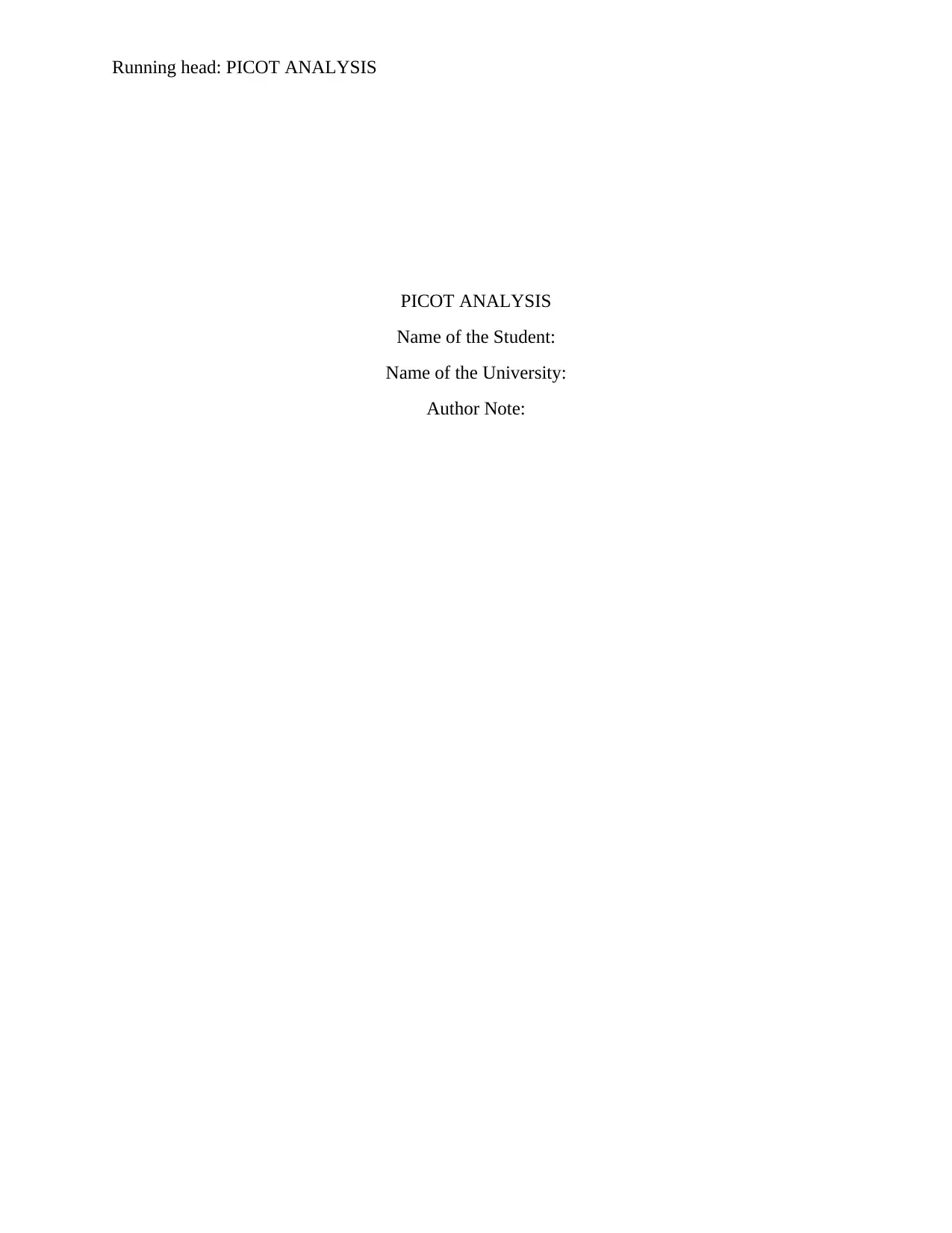
Running head: PICOT ANALYSIS
PICOT ANALYSIS
Name of the Student:
Name of the University:
Author Note:
PICOT ANALYSIS
Name of the Student:
Name of the University:
Author Note:
Paraphrase This Document
Need a fresh take? Get an instant paraphrase of this document with our AI Paraphraser
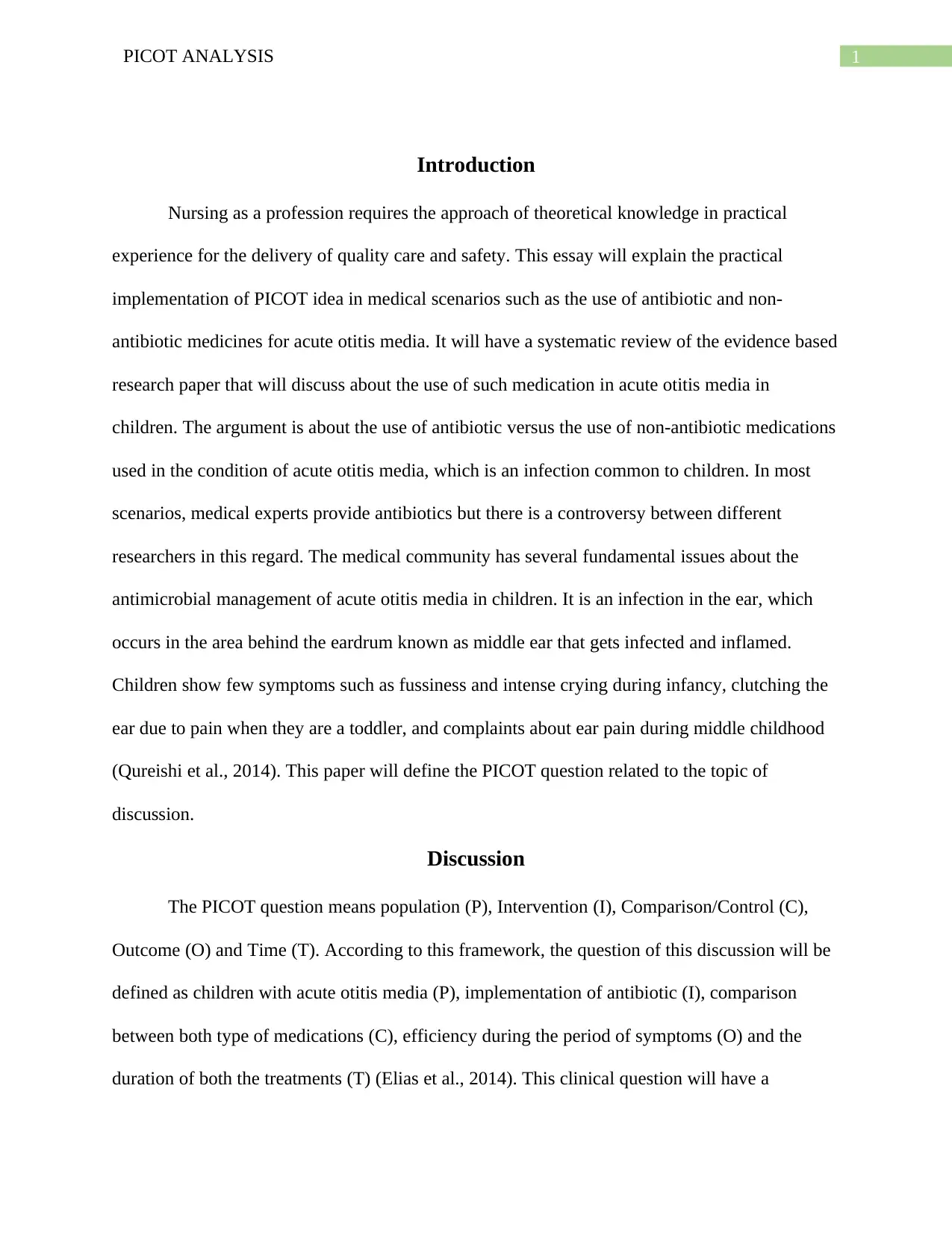
1PICOT ANALYSIS
Introduction
Nursing as a profession requires the approach of theoretical knowledge in practical
experience for the delivery of quality care and safety. This essay will explain the practical
implementation of PICOT idea in medical scenarios such as the use of antibiotic and non-
antibiotic medicines for acute otitis media. It will have a systematic review of the evidence based
research paper that will discuss about the use of such medication in acute otitis media in
children. The argument is about the use of antibiotic versus the use of non-antibiotic medications
used in the condition of acute otitis media, which is an infection common to children. In most
scenarios, medical experts provide antibiotics but there is a controversy between different
researchers in this regard. The medical community has several fundamental issues about the
antimicrobial management of acute otitis media in children. It is an infection in the ear, which
occurs in the area behind the eardrum known as middle ear that gets infected and inflamed.
Children show few symptoms such as fussiness and intense crying during infancy, clutching the
ear due to pain when they are a toddler, and complaints about ear pain during middle childhood
(Qureishi et al., 2014). This paper will define the PICOT question related to the topic of
discussion.
Discussion
The PICOT question means population (P), Intervention (I), Comparison/Control (C),
Outcome (O) and Time (T). According to this framework, the question of this discussion will be
defined as children with acute otitis media (P), implementation of antibiotic (I), comparison
between both type of medications (C), efficiency during the period of symptoms (O) and the
duration of both the treatments (T) (Elias et al., 2014). This clinical question will have a
Introduction
Nursing as a profession requires the approach of theoretical knowledge in practical
experience for the delivery of quality care and safety. This essay will explain the practical
implementation of PICOT idea in medical scenarios such as the use of antibiotic and non-
antibiotic medicines for acute otitis media. It will have a systematic review of the evidence based
research paper that will discuss about the use of such medication in acute otitis media in
children. The argument is about the use of antibiotic versus the use of non-antibiotic medications
used in the condition of acute otitis media, which is an infection common to children. In most
scenarios, medical experts provide antibiotics but there is a controversy between different
researchers in this regard. The medical community has several fundamental issues about the
antimicrobial management of acute otitis media in children. It is an infection in the ear, which
occurs in the area behind the eardrum known as middle ear that gets infected and inflamed.
Children show few symptoms such as fussiness and intense crying during infancy, clutching the
ear due to pain when they are a toddler, and complaints about ear pain during middle childhood
(Qureishi et al., 2014). This paper will define the PICOT question related to the topic of
discussion.
Discussion
The PICOT question means population (P), Intervention (I), Comparison/Control (C),
Outcome (O) and Time (T). According to this framework, the question of this discussion will be
defined as children with acute otitis media (P), implementation of antibiotic (I), comparison
between both type of medications (C), efficiency during the period of symptoms (O) and the
duration of both the treatments (T) (Elias et al., 2014). This clinical question will have a
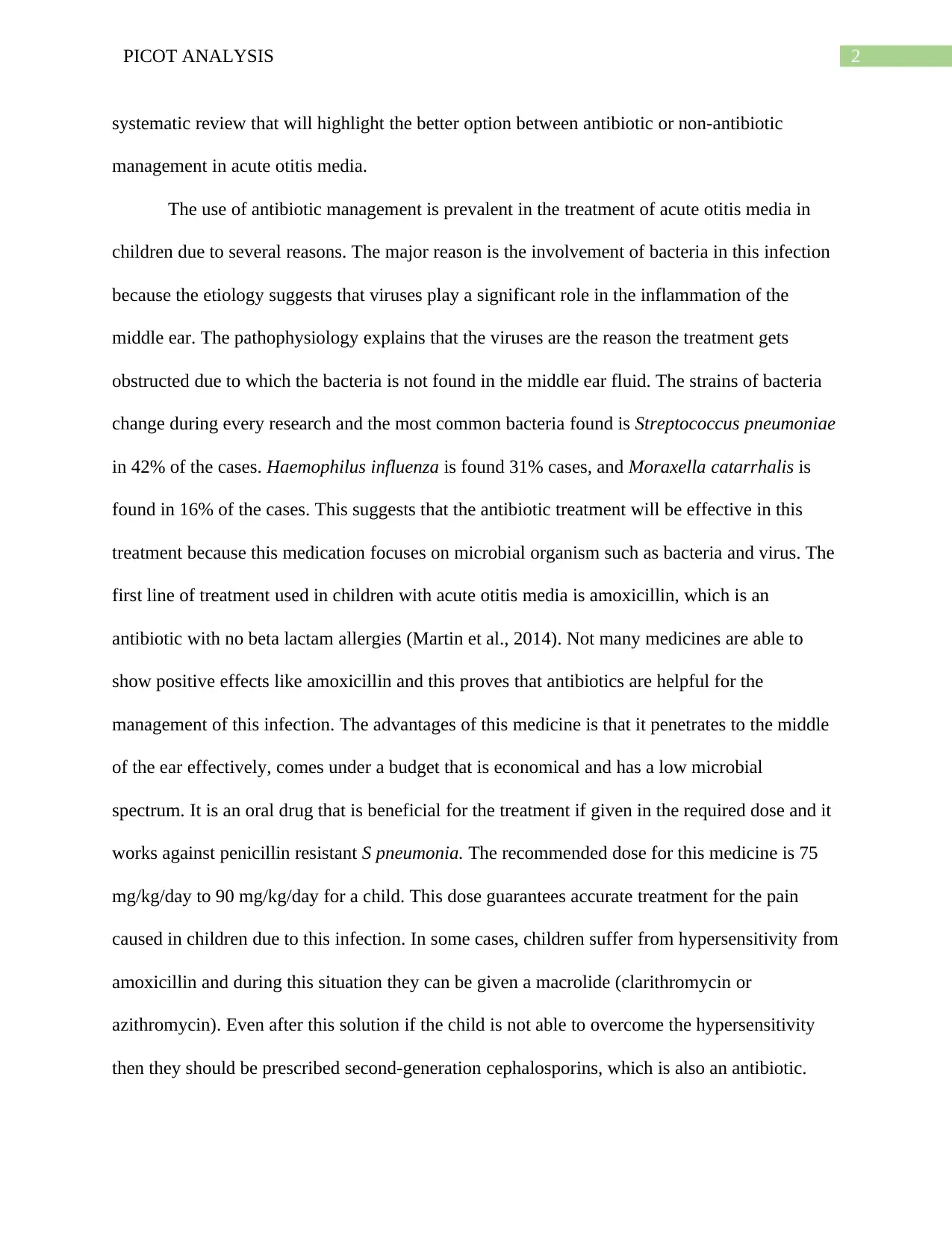
2PICOT ANALYSIS
systematic review that will highlight the better option between antibiotic or non-antibiotic
management in acute otitis media.
The use of antibiotic management is prevalent in the treatment of acute otitis media in
children due to several reasons. The major reason is the involvement of bacteria in this infection
because the etiology suggests that viruses play a significant role in the inflammation of the
middle ear. The pathophysiology explains that the viruses are the reason the treatment gets
obstructed due to which the bacteria is not found in the middle ear fluid. The strains of bacteria
change during every research and the most common bacteria found is Streptococcus pneumoniae
in 42% of the cases. Haemophilus influenza is found 31% cases, and Moraxella catarrhalis is
found in 16% of the cases. This suggests that the antibiotic treatment will be effective in this
treatment because this medication focuses on microbial organism such as bacteria and virus. The
first line of treatment used in children with acute otitis media is amoxicillin, which is an
antibiotic with no beta lactam allergies (Martin et al., 2014). Not many medicines are able to
show positive effects like amoxicillin and this proves that antibiotics are helpful for the
management of this infection. The advantages of this medicine is that it penetrates to the middle
of the ear effectively, comes under a budget that is economical and has a low microbial
spectrum. It is an oral drug that is beneficial for the treatment if given in the required dose and it
works against penicillin resistant S pneumonia. The recommended dose for this medicine is 75
mg/kg/day to 90 mg/kg/day for a child. This dose guarantees accurate treatment for the pain
caused in children due to this infection. In some cases, children suffer from hypersensitivity from
amoxicillin and during this situation they can be given a macrolide (clarithromycin or
azithromycin). Even after this solution if the child is not able to overcome the hypersensitivity
then they should be prescribed second-generation cephalosporins, which is also an antibiotic.
systematic review that will highlight the better option between antibiotic or non-antibiotic
management in acute otitis media.
The use of antibiotic management is prevalent in the treatment of acute otitis media in
children due to several reasons. The major reason is the involvement of bacteria in this infection
because the etiology suggests that viruses play a significant role in the inflammation of the
middle ear. The pathophysiology explains that the viruses are the reason the treatment gets
obstructed due to which the bacteria is not found in the middle ear fluid. The strains of bacteria
change during every research and the most common bacteria found is Streptococcus pneumoniae
in 42% of the cases. Haemophilus influenza is found 31% cases, and Moraxella catarrhalis is
found in 16% of the cases. This suggests that the antibiotic treatment will be effective in this
treatment because this medication focuses on microbial organism such as bacteria and virus. The
first line of treatment used in children with acute otitis media is amoxicillin, which is an
antibiotic with no beta lactam allergies (Martin et al., 2014). Not many medicines are able to
show positive effects like amoxicillin and this proves that antibiotics are helpful for the
management of this infection. The advantages of this medicine is that it penetrates to the middle
of the ear effectively, comes under a budget that is economical and has a low microbial
spectrum. It is an oral drug that is beneficial for the treatment if given in the required dose and it
works against penicillin resistant S pneumonia. The recommended dose for this medicine is 75
mg/kg/day to 90 mg/kg/day for a child. This dose guarantees accurate treatment for the pain
caused in children due to this infection. In some cases, children suffer from hypersensitivity from
amoxicillin and during this situation they can be given a macrolide (clarithromycin or
azithromycin). Even after this solution if the child is not able to overcome the hypersensitivity
then they should be prescribed second-generation cephalosporins, which is also an antibiotic.
⊘ This is a preview!⊘
Do you want full access?
Subscribe today to unlock all pages.

Trusted by 1+ million students worldwide
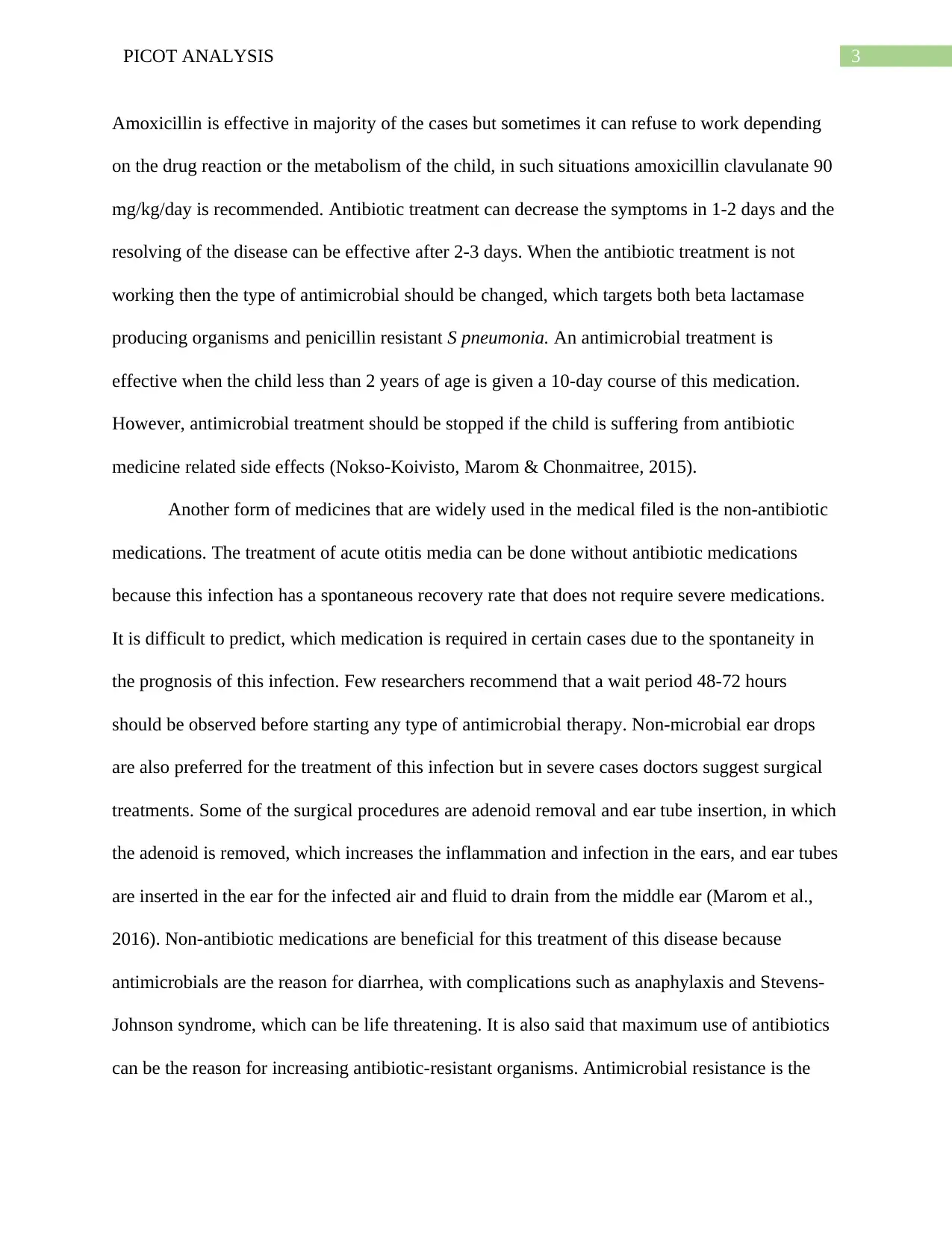
3PICOT ANALYSIS
Amoxicillin is effective in majority of the cases but sometimes it can refuse to work depending
on the drug reaction or the metabolism of the child, in such situations amoxicillin clavulanate 90
mg/kg/day is recommended. Antibiotic treatment can decrease the symptoms in 1-2 days and the
resolving of the disease can be effective after 2-3 days. When the antibiotic treatment is not
working then the type of antimicrobial should be changed, which targets both beta lactamase
producing organisms and penicillin resistant S pneumonia. An antimicrobial treatment is
effective when the child less than 2 years of age is given a 10-day course of this medication.
However, antimicrobial treatment should be stopped if the child is suffering from antibiotic
medicine related side effects (Nokso-Koivisto, Marom & Chonmaitree, 2015).
Another form of medicines that are widely used in the medical filed is the non-antibiotic
medications. The treatment of acute otitis media can be done without antibiotic medications
because this infection has a spontaneous recovery rate that does not require severe medications.
It is difficult to predict, which medication is required in certain cases due to the spontaneity in
the prognosis of this infection. Few researchers recommend that a wait period 48-72 hours
should be observed before starting any type of antimicrobial therapy. Non-microbial ear drops
are also preferred for the treatment of this infection but in severe cases doctors suggest surgical
treatments. Some of the surgical procedures are adenoid removal and ear tube insertion, in which
the adenoid is removed, which increases the inflammation and infection in the ears, and ear tubes
are inserted in the ear for the infected air and fluid to drain from the middle ear (Marom et al.,
2016). Non-antibiotic medications are beneficial for this treatment of this disease because
antimicrobials are the reason for diarrhea, with complications such as anaphylaxis and Stevens-
Johnson syndrome, which can be life threatening. It is also said that maximum use of antibiotics
can be the reason for increasing antibiotic-resistant organisms. Antimicrobial resistance is the
Amoxicillin is effective in majority of the cases but sometimes it can refuse to work depending
on the drug reaction or the metabolism of the child, in such situations amoxicillin clavulanate 90
mg/kg/day is recommended. Antibiotic treatment can decrease the symptoms in 1-2 days and the
resolving of the disease can be effective after 2-3 days. When the antibiotic treatment is not
working then the type of antimicrobial should be changed, which targets both beta lactamase
producing organisms and penicillin resistant S pneumonia. An antimicrobial treatment is
effective when the child less than 2 years of age is given a 10-day course of this medication.
However, antimicrobial treatment should be stopped if the child is suffering from antibiotic
medicine related side effects (Nokso-Koivisto, Marom & Chonmaitree, 2015).
Another form of medicines that are widely used in the medical filed is the non-antibiotic
medications. The treatment of acute otitis media can be done without antibiotic medications
because this infection has a spontaneous recovery rate that does not require severe medications.
It is difficult to predict, which medication is required in certain cases due to the spontaneity in
the prognosis of this infection. Few researchers recommend that a wait period 48-72 hours
should be observed before starting any type of antimicrobial therapy. Non-microbial ear drops
are also preferred for the treatment of this infection but in severe cases doctors suggest surgical
treatments. Some of the surgical procedures are adenoid removal and ear tube insertion, in which
the adenoid is removed, which increases the inflammation and infection in the ears, and ear tubes
are inserted in the ear for the infected air and fluid to drain from the middle ear (Marom et al.,
2016). Non-antibiotic medications are beneficial for this treatment of this disease because
antimicrobials are the reason for diarrhea, with complications such as anaphylaxis and Stevens-
Johnson syndrome, which can be life threatening. It is also said that maximum use of antibiotics
can be the reason for increasing antibiotic-resistant organisms. Antimicrobial resistance is the
Paraphrase This Document
Need a fresh take? Get an instant paraphrase of this document with our AI Paraphraser
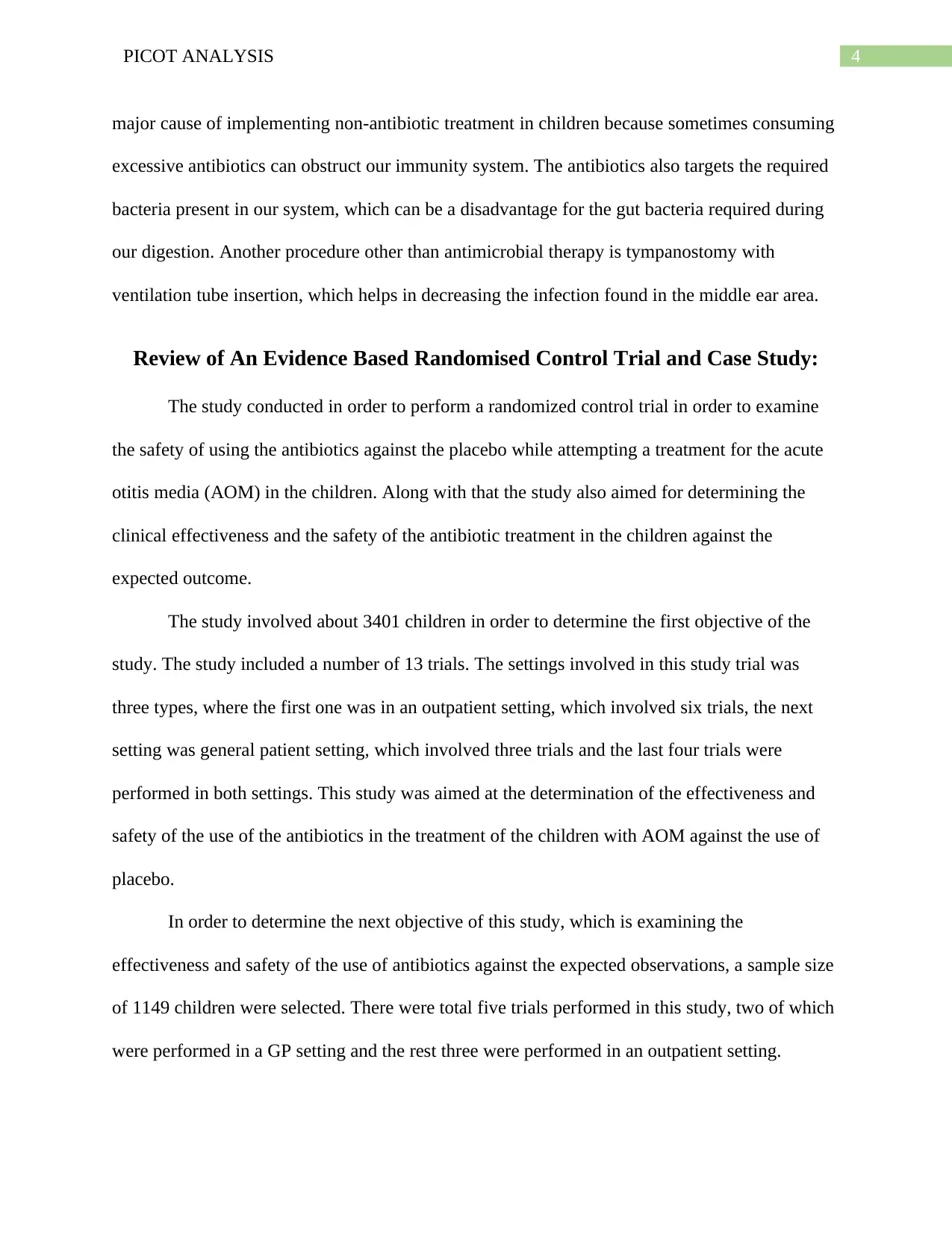
4PICOT ANALYSIS
major cause of implementing non-antibiotic treatment in children because sometimes consuming
excessive antibiotics can obstruct our immunity system. The antibiotics also targets the required
bacteria present in our system, which can be a disadvantage for the gut bacteria required during
our digestion. Another procedure other than antimicrobial therapy is tympanostomy with
ventilation tube insertion, which helps in decreasing the infection found in the middle ear area.
Review of An Evidence Based Randomised Control Trial and Case Study:
The study conducted in order to perform a randomized control trial in order to examine
the safety of using the antibiotics against the placebo while attempting a treatment for the acute
otitis media (AOM) in the children. Along with that the study also aimed for determining the
clinical effectiveness and the safety of the antibiotic treatment in the children against the
expected outcome.
The study involved about 3401 children in order to determine the first objective of the
study. The study included a number of 13 trials. The settings involved in this study trial was
three types, where the first one was in an outpatient setting, which involved six trials, the next
setting was general patient setting, which involved three trials and the last four trials were
performed in both settings. This study was aimed at the determination of the effectiveness and
safety of the use of the antibiotics in the treatment of the children with AOM against the use of
placebo.
In order to determine the next objective of this study, which is examining the
effectiveness and safety of the use of antibiotics against the expected observations, a sample size
of 1149 children were selected. There were total five trials performed in this study, two of which
were performed in a GP setting and the rest three were performed in an outpatient setting.
major cause of implementing non-antibiotic treatment in children because sometimes consuming
excessive antibiotics can obstruct our immunity system. The antibiotics also targets the required
bacteria present in our system, which can be a disadvantage for the gut bacteria required during
our digestion. Another procedure other than antimicrobial therapy is tympanostomy with
ventilation tube insertion, which helps in decreasing the infection found in the middle ear area.
Review of An Evidence Based Randomised Control Trial and Case Study:
The study conducted in order to perform a randomized control trial in order to examine
the safety of using the antibiotics against the placebo while attempting a treatment for the acute
otitis media (AOM) in the children. Along with that the study also aimed for determining the
clinical effectiveness and the safety of the antibiotic treatment in the children against the
expected outcome.
The study involved about 3401 children in order to determine the first objective of the
study. The study included a number of 13 trials. The settings involved in this study trial was
three types, where the first one was in an outpatient setting, which involved six trials, the next
setting was general patient setting, which involved three trials and the last four trials were
performed in both settings. This study was aimed at the determination of the effectiveness and
safety of the use of the antibiotics in the treatment of the children with AOM against the use of
placebo.
In order to determine the next objective of this study, which is examining the
effectiveness and safety of the use of antibiotics against the expected observations, a sample size
of 1149 children were selected. There were total five trials performed in this study, two of which
were performed in a GP setting and the rest three were performed in an outpatient setting.
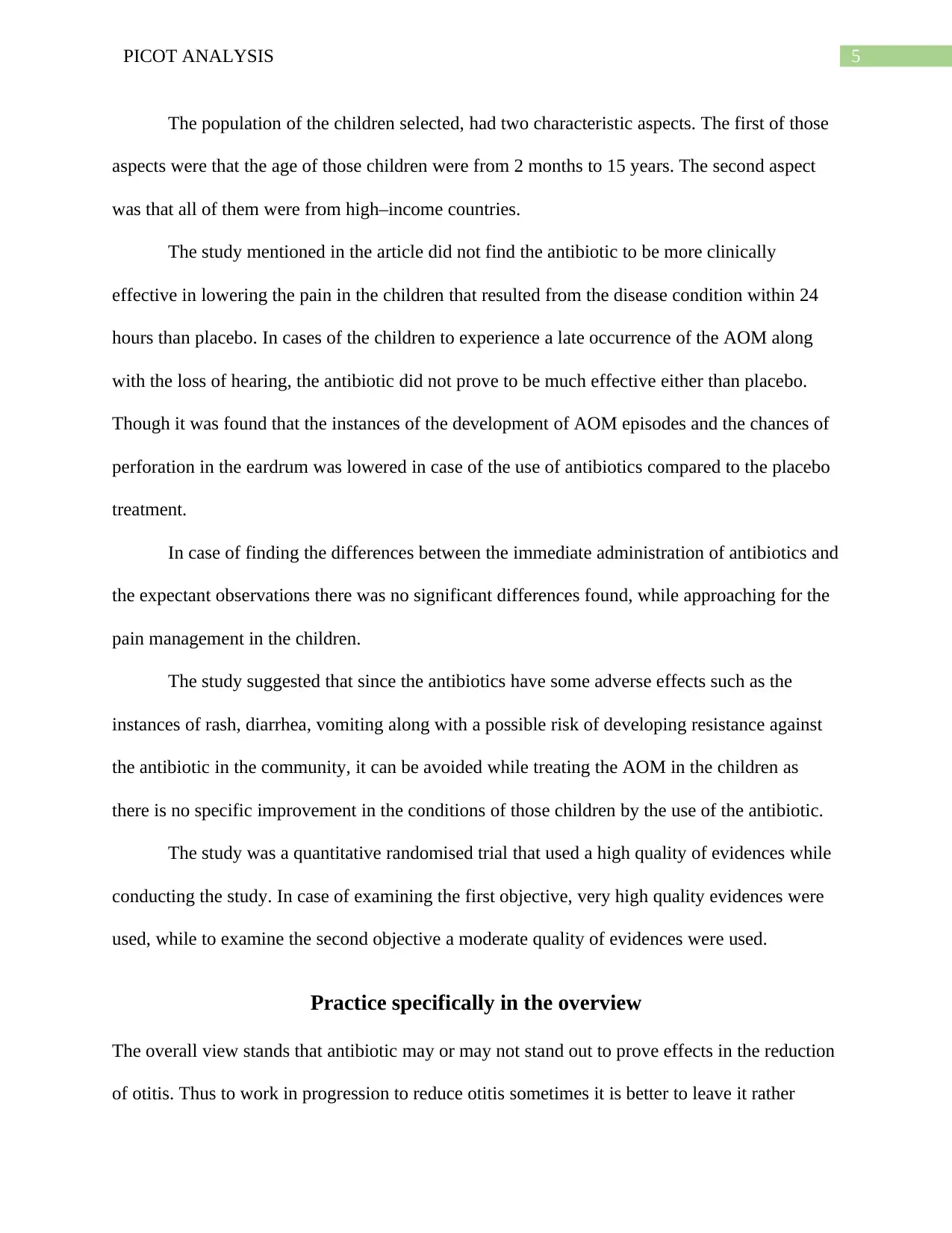
5PICOT ANALYSIS
The population of the children selected, had two characteristic aspects. The first of those
aspects were that the age of those children were from 2 months to 15 years. The second aspect
was that all of them were from high–income countries.
The study mentioned in the article did not find the antibiotic to be more clinically
effective in lowering the pain in the children that resulted from the disease condition within 24
hours than placebo. In cases of the children to experience a late occurrence of the AOM along
with the loss of hearing, the antibiotic did not prove to be much effective either than placebo.
Though it was found that the instances of the development of AOM episodes and the chances of
perforation in the eardrum was lowered in case of the use of antibiotics compared to the placebo
treatment.
In case of finding the differences between the immediate administration of antibiotics and
the expectant observations there was no significant differences found, while approaching for the
pain management in the children.
The study suggested that since the antibiotics have some adverse effects such as the
instances of rash, diarrhea, vomiting along with a possible risk of developing resistance against
the antibiotic in the community, it can be avoided while treating the AOM in the children as
there is no specific improvement in the conditions of those children by the use of the antibiotic.
The study was a quantitative randomised trial that used a high quality of evidences while
conducting the study. In case of examining the first objective, very high quality evidences were
used, while to examine the second objective a moderate quality of evidences were used.
Practice specifically in the overview
The overall view stands that antibiotic may or may not stand out to prove effects in the reduction
of otitis. Thus to work in progression to reduce otitis sometimes it is better to leave it rather
The population of the children selected, had two characteristic aspects. The first of those
aspects were that the age of those children were from 2 months to 15 years. The second aspect
was that all of them were from high–income countries.
The study mentioned in the article did not find the antibiotic to be more clinically
effective in lowering the pain in the children that resulted from the disease condition within 24
hours than placebo. In cases of the children to experience a late occurrence of the AOM along
with the loss of hearing, the antibiotic did not prove to be much effective either than placebo.
Though it was found that the instances of the development of AOM episodes and the chances of
perforation in the eardrum was lowered in case of the use of antibiotics compared to the placebo
treatment.
In case of finding the differences between the immediate administration of antibiotics and
the expectant observations there was no significant differences found, while approaching for the
pain management in the children.
The study suggested that since the antibiotics have some adverse effects such as the
instances of rash, diarrhea, vomiting along with a possible risk of developing resistance against
the antibiotic in the community, it can be avoided while treating the AOM in the children as
there is no specific improvement in the conditions of those children by the use of the antibiotic.
The study was a quantitative randomised trial that used a high quality of evidences while
conducting the study. In case of examining the first objective, very high quality evidences were
used, while to examine the second objective a moderate quality of evidences were used.
Practice specifically in the overview
The overall view stands that antibiotic may or may not stand out to prove effects in the reduction
of otitis. Thus to work in progression to reduce otitis sometimes it is better to leave it rather
⊘ This is a preview!⊘
Do you want full access?
Subscribe today to unlock all pages.

Trusted by 1+ million students worldwide
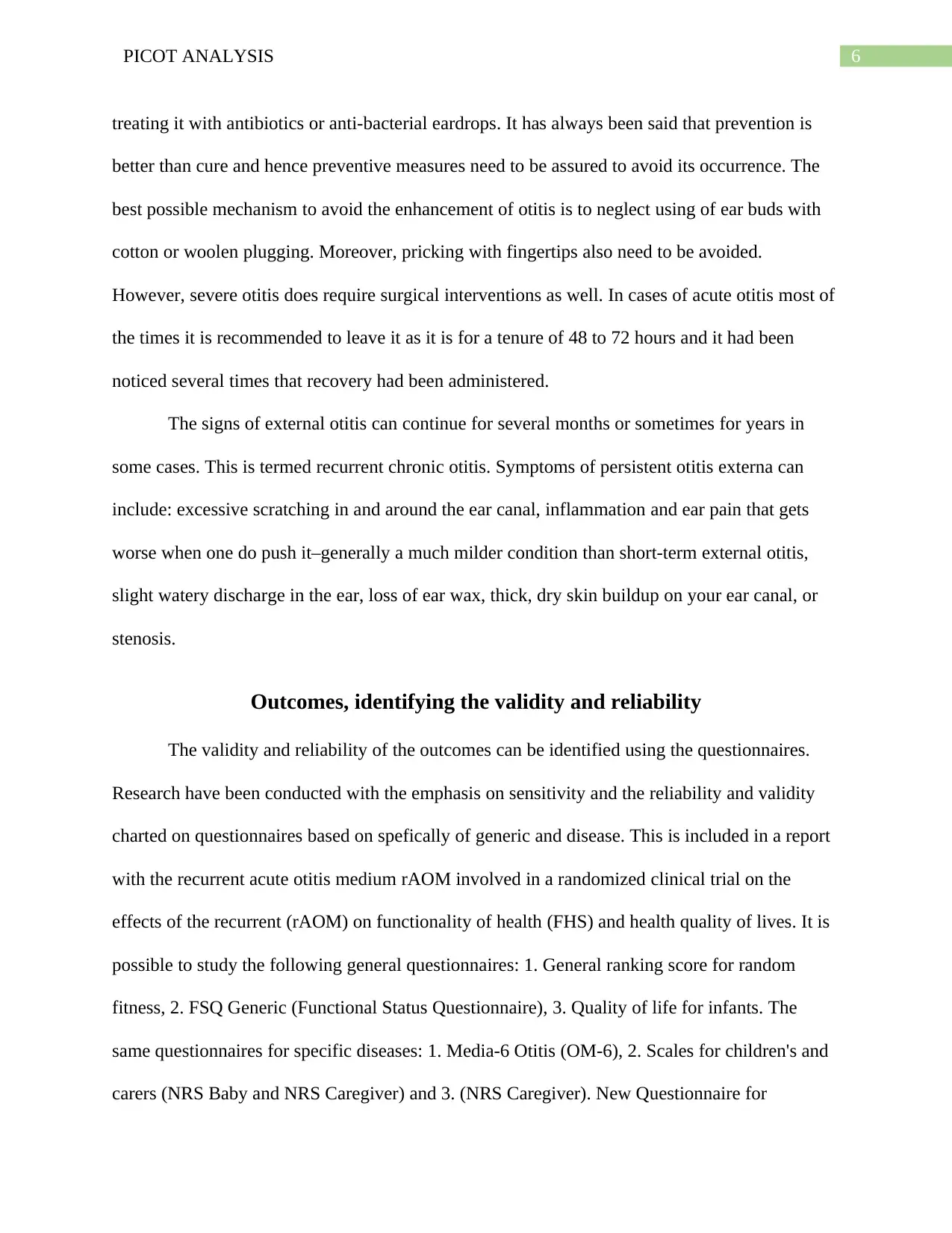
6PICOT ANALYSIS
treating it with antibiotics or anti-bacterial eardrops. It has always been said that prevention is
better than cure and hence preventive measures need to be assured to avoid its occurrence. The
best possible mechanism to avoid the enhancement of otitis is to neglect using of ear buds with
cotton or woolen plugging. Moreover, pricking with fingertips also need to be avoided.
However, severe otitis does require surgical interventions as well. In cases of acute otitis most of
the times it is recommended to leave it as it is for a tenure of 48 to 72 hours and it had been
noticed several times that recovery had been administered.
The signs of external otitis can continue for several months or sometimes for years in
some cases. This is termed recurrent chronic otitis. Symptoms of persistent otitis externa can
include: excessive scratching in and around the ear canal, inflammation and ear pain that gets
worse when one do push it–generally a much milder condition than short-term external otitis,
slight watery discharge in the ear, loss of ear wax, thick, dry skin buildup on your ear canal, or
stenosis.
Outcomes, identifying the validity and reliability
The validity and reliability of the outcomes can be identified using the questionnaires.
Research have been conducted with the emphasis on sensitivity and the reliability and validity
charted on questionnaires based on spefically of generic and disease. This is included in a report
with the recurrent acute otitis medium rAOM involved in a randomized clinical trial on the
effects of the recurrent (rAOM) on functionality of health (FHS) and health quality of lives. It is
possible to study the following general questionnaires: 1. General ranking score for random
fitness, 2. FSQ Generic (Functional Status Questionnaire), 3. Quality of life for infants. The
same questionnaires for specific diseases: 1. Media-6 Otitis (OM-6), 2. Scales for children's and
carers (NRS Baby and NRS Caregiver) and 3. (NRS Caregiver). New Questionnaire for
treating it with antibiotics or anti-bacterial eardrops. It has always been said that prevention is
better than cure and hence preventive measures need to be assured to avoid its occurrence. The
best possible mechanism to avoid the enhancement of otitis is to neglect using of ear buds with
cotton or woolen plugging. Moreover, pricking with fingertips also need to be avoided.
However, severe otitis does require surgical interventions as well. In cases of acute otitis most of
the times it is recommended to leave it as it is for a tenure of 48 to 72 hours and it had been
noticed several times that recovery had been administered.
The signs of external otitis can continue for several months or sometimes for years in
some cases. This is termed recurrent chronic otitis. Symptoms of persistent otitis externa can
include: excessive scratching in and around the ear canal, inflammation and ear pain that gets
worse when one do push it–generally a much milder condition than short-term external otitis,
slight watery discharge in the ear, loss of ear wax, thick, dry skin buildup on your ear canal, or
stenosis.
Outcomes, identifying the validity and reliability
The validity and reliability of the outcomes can be identified using the questionnaires.
Research have been conducted with the emphasis on sensitivity and the reliability and validity
charted on questionnaires based on spefically of generic and disease. This is included in a report
with the recurrent acute otitis medium rAOM involved in a randomized clinical trial on the
effects of the recurrent (rAOM) on functionality of health (FHS) and health quality of lives. It is
possible to study the following general questionnaires: 1. General ranking score for random
fitness, 2. FSQ Generic (Functional Status Questionnaire), 3. Quality of life for infants. The
same questionnaires for specific diseases: 1. Media-6 Otitis (OM-6), 2. Scales for children's and
carers (NRS Baby and NRS Caregiver) and 3. (NRS Caregiver). New Questionnaire for
Paraphrase This Document
Need a fresh take? Get an instant paraphrase of this document with our AI Paraphraser
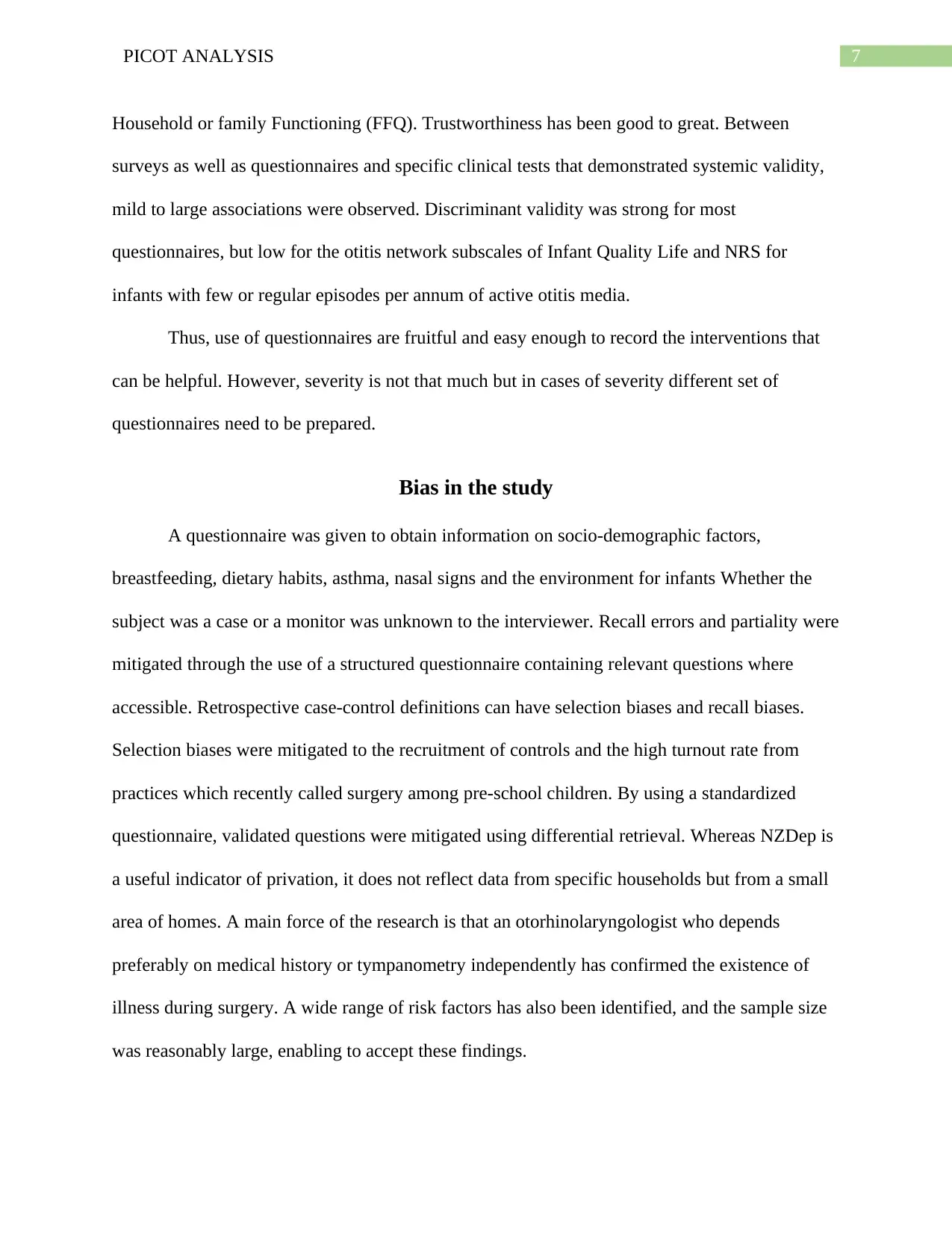
7PICOT ANALYSIS
Household or family Functioning (FFQ). Trustworthiness has been good to great. Between
surveys as well as questionnaires and specific clinical tests that demonstrated systemic validity,
mild to large associations were observed. Discriminant validity was strong for most
questionnaires, but low for the otitis network subscales of Infant Quality Life and NRS for
infants with few or regular episodes per annum of active otitis media.
Thus, use of questionnaires are fruitful and easy enough to record the interventions that
can be helpful. However, severity is not that much but in cases of severity different set of
questionnaires need to be prepared.
Bias in the study
A questionnaire was given to obtain information on socio-demographic factors,
breastfeeding, dietary habits, asthma, nasal signs and the environment for infants Whether the
subject was a case or a monitor was unknown to the interviewer. Recall errors and partiality were
mitigated through the use of a structured questionnaire containing relevant questions where
accessible. Retrospective case-control definitions can have selection biases and recall biases.
Selection biases were mitigated to the recruitment of controls and the high turnout rate from
practices which recently called surgery among pre-school children. By using a standardized
questionnaire, validated questions were mitigated using differential retrieval. Whereas NZDep is
a useful indicator of privation, it does not reflect data from specific households but from a small
area of homes. A main force of the research is that an otorhinolaryngologist who depends
preferably on medical history or tympanometry independently has confirmed the existence of
illness during surgery. A wide range of risk factors has also been identified, and the sample size
was reasonably large, enabling to accept these findings.
Household or family Functioning (FFQ). Trustworthiness has been good to great. Between
surveys as well as questionnaires and specific clinical tests that demonstrated systemic validity,
mild to large associations were observed. Discriminant validity was strong for most
questionnaires, but low for the otitis network subscales of Infant Quality Life and NRS for
infants with few or regular episodes per annum of active otitis media.
Thus, use of questionnaires are fruitful and easy enough to record the interventions that
can be helpful. However, severity is not that much but in cases of severity different set of
questionnaires need to be prepared.
Bias in the study
A questionnaire was given to obtain information on socio-demographic factors,
breastfeeding, dietary habits, asthma, nasal signs and the environment for infants Whether the
subject was a case or a monitor was unknown to the interviewer. Recall errors and partiality were
mitigated through the use of a structured questionnaire containing relevant questions where
accessible. Retrospective case-control definitions can have selection biases and recall biases.
Selection biases were mitigated to the recruitment of controls and the high turnout rate from
practices which recently called surgery among pre-school children. By using a standardized
questionnaire, validated questions were mitigated using differential retrieval. Whereas NZDep is
a useful indicator of privation, it does not reflect data from specific households but from a small
area of homes. A main force of the research is that an otorhinolaryngologist who depends
preferably on medical history or tympanometry independently has confirmed the existence of
illness during surgery. A wide range of risk factors has also been identified, and the sample size
was reasonably large, enabling to accept these findings.
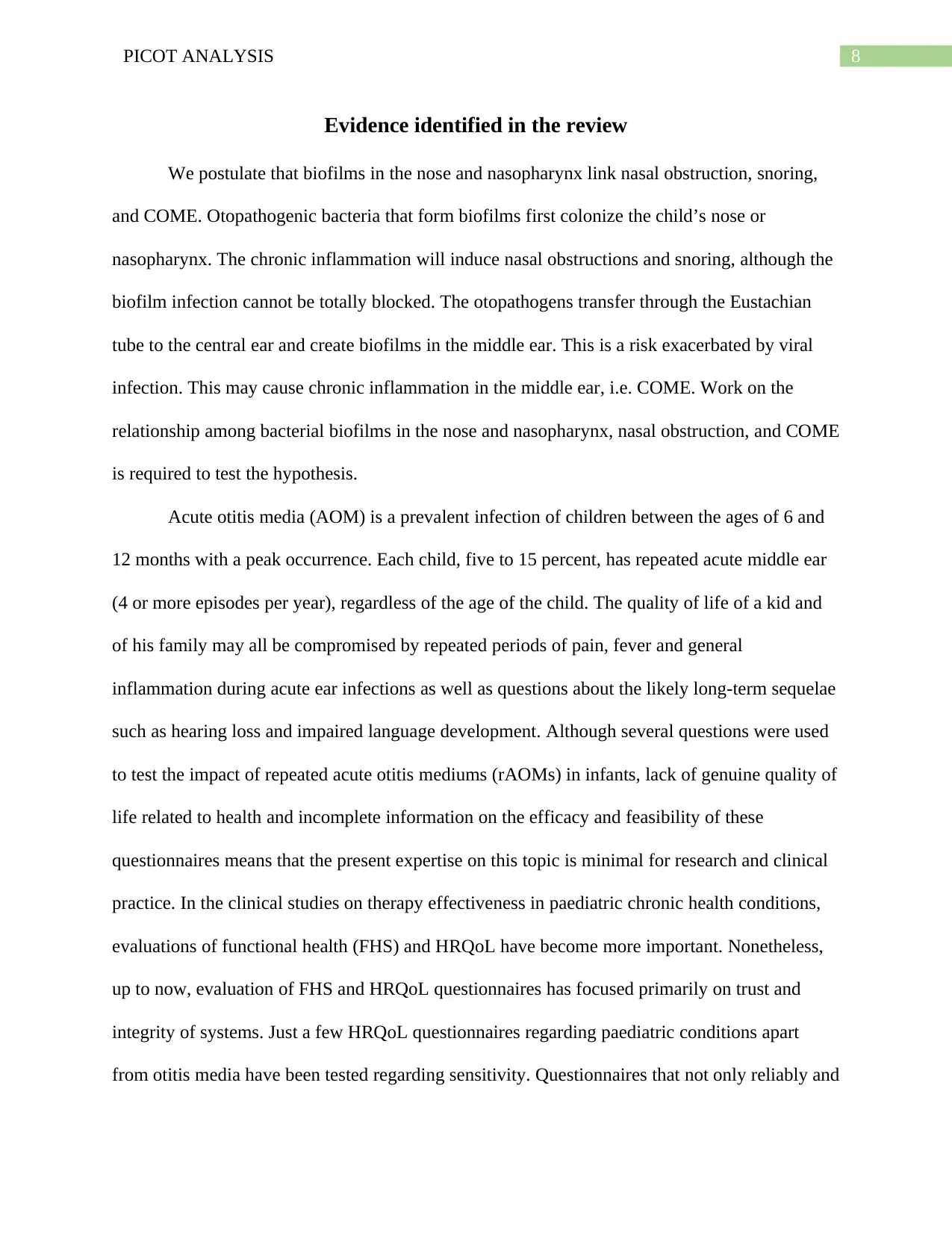
8PICOT ANALYSIS
Evidence identified in the review
We postulate that biofilms in the nose and nasopharynx link nasal obstruction, snoring,
and COME. Otopathogenic bacteria that form biofilms first colonize the child’s nose or
nasopharynx. The chronic inflammation will induce nasal obstructions and snoring, although the
biofilm infection cannot be totally blocked. The otopathogens transfer through the Eustachian
tube to the central ear and create biofilms in the middle ear. This is a risk exacerbated by viral
infection. This may cause chronic inflammation in the middle ear, i.e. COME. Work on the
relationship among bacterial biofilms in the nose and nasopharynx, nasal obstruction, and COME
is required to test the hypothesis.
Acute otitis media (AOM) is a prevalent infection of children between the ages of 6 and
12 months with a peak occurrence. Each child, five to 15 percent, has repeated acute middle ear
(4 or more episodes per year), regardless of the age of the child. The quality of life of a kid and
of his family may all be compromised by repeated periods of pain, fever and general
inflammation during acute ear infections as well as questions about the likely long-term sequelae
such as hearing loss and impaired language development. Although several questions were used
to test the impact of repeated acute otitis mediums (rAOMs) in infants, lack of genuine quality of
life related to health and incomplete information on the efficacy and feasibility of these
questionnaires means that the present expertise on this topic is minimal for research and clinical
practice. In the clinical studies on therapy effectiveness in paediatric chronic health conditions,
evaluations of functional health (FHS) and HRQoL have become more important. Nonetheless,
up to now, evaluation of FHS and HRQoL questionnaires has focused primarily on trust and
integrity of systems. Just a few HRQoL questionnaires regarding paediatric conditions apart
from otitis media have been tested regarding sensitivity. Questionnaires that not only reliably and
Evidence identified in the review
We postulate that biofilms in the nose and nasopharynx link nasal obstruction, snoring,
and COME. Otopathogenic bacteria that form biofilms first colonize the child’s nose or
nasopharynx. The chronic inflammation will induce nasal obstructions and snoring, although the
biofilm infection cannot be totally blocked. The otopathogens transfer through the Eustachian
tube to the central ear and create biofilms in the middle ear. This is a risk exacerbated by viral
infection. This may cause chronic inflammation in the middle ear, i.e. COME. Work on the
relationship among bacterial biofilms in the nose and nasopharynx, nasal obstruction, and COME
is required to test the hypothesis.
Acute otitis media (AOM) is a prevalent infection of children between the ages of 6 and
12 months with a peak occurrence. Each child, five to 15 percent, has repeated acute middle ear
(4 or more episodes per year), regardless of the age of the child. The quality of life of a kid and
of his family may all be compromised by repeated periods of pain, fever and general
inflammation during acute ear infections as well as questions about the likely long-term sequelae
such as hearing loss and impaired language development. Although several questions were used
to test the impact of repeated acute otitis mediums (rAOMs) in infants, lack of genuine quality of
life related to health and incomplete information on the efficacy and feasibility of these
questionnaires means that the present expertise on this topic is minimal for research and clinical
practice. In the clinical studies on therapy effectiveness in paediatric chronic health conditions,
evaluations of functional health (FHS) and HRQoL have become more important. Nonetheless,
up to now, evaluation of FHS and HRQoL questionnaires has focused primarily on trust and
integrity of systems. Just a few HRQoL questionnaires regarding paediatric conditions apart
from otitis media have been tested regarding sensitivity. Questionnaires that not only reliably and
⊘ This is a preview!⊘
Do you want full access?
Subscribe today to unlock all pages.

Trusted by 1+ million students worldwide
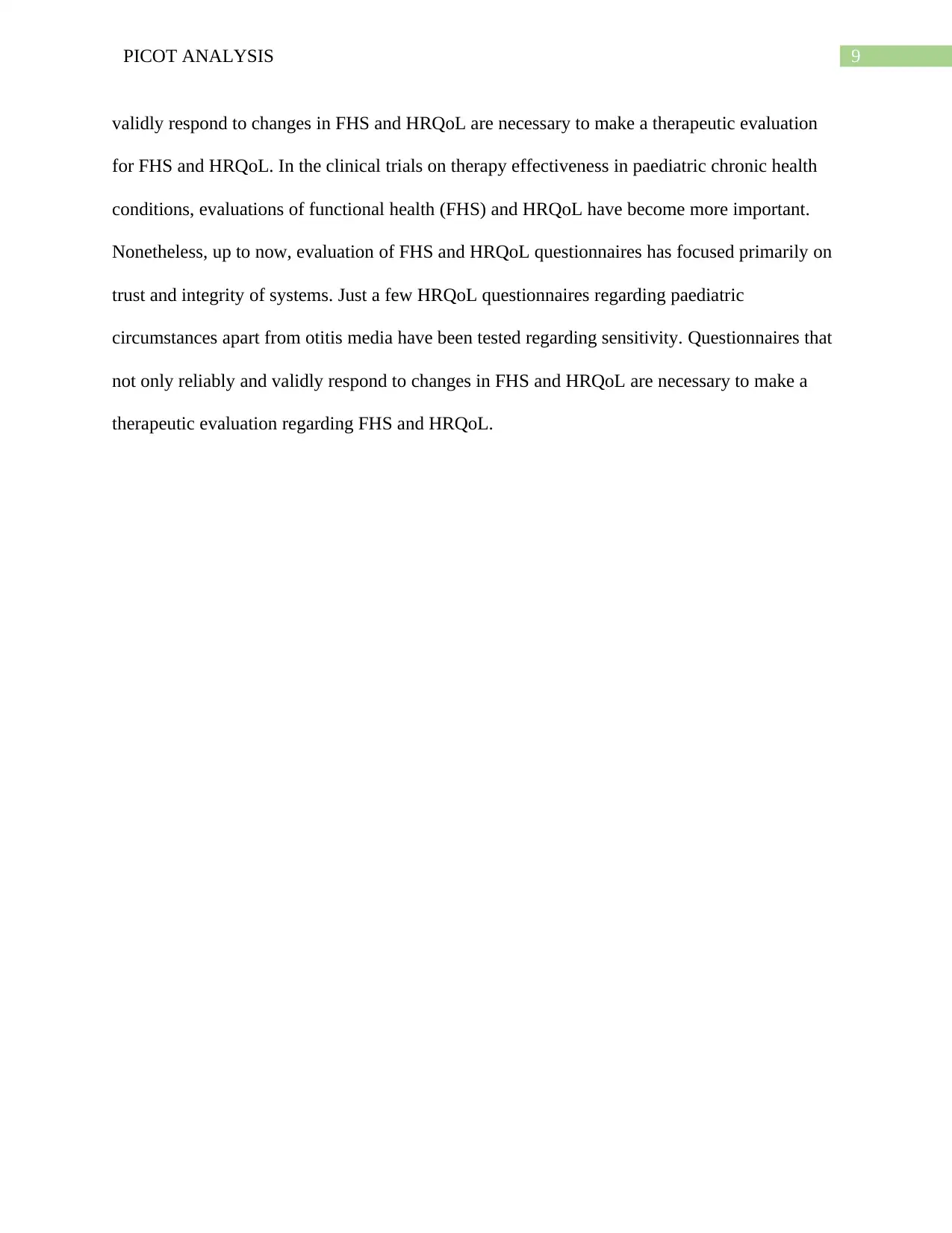
9PICOT ANALYSIS
validly respond to changes in FHS and HRQoL are necessary to make a therapeutic evaluation
for FHS and HRQoL. In the clinical trials on therapy effectiveness in paediatric chronic health
conditions, evaluations of functional health (FHS) and HRQoL have become more important.
Nonetheless, up to now, evaluation of FHS and HRQoL questionnaires has focused primarily on
trust and integrity of systems. Just a few HRQoL questionnaires regarding paediatric
circumstances apart from otitis media have been tested regarding sensitivity. Questionnaires that
not only reliably and validly respond to changes in FHS and HRQoL are necessary to make a
therapeutic evaluation regarding FHS and HRQoL.
validly respond to changes in FHS and HRQoL are necessary to make a therapeutic evaluation
for FHS and HRQoL. In the clinical trials on therapy effectiveness in paediatric chronic health
conditions, evaluations of functional health (FHS) and HRQoL have become more important.
Nonetheless, up to now, evaluation of FHS and HRQoL questionnaires has focused primarily on
trust and integrity of systems. Just a few HRQoL questionnaires regarding paediatric
circumstances apart from otitis media have been tested regarding sensitivity. Questionnaires that
not only reliably and validly respond to changes in FHS and HRQoL are necessary to make a
therapeutic evaluation regarding FHS and HRQoL.
Paraphrase This Document
Need a fresh take? Get an instant paraphrase of this document with our AI Paraphraser
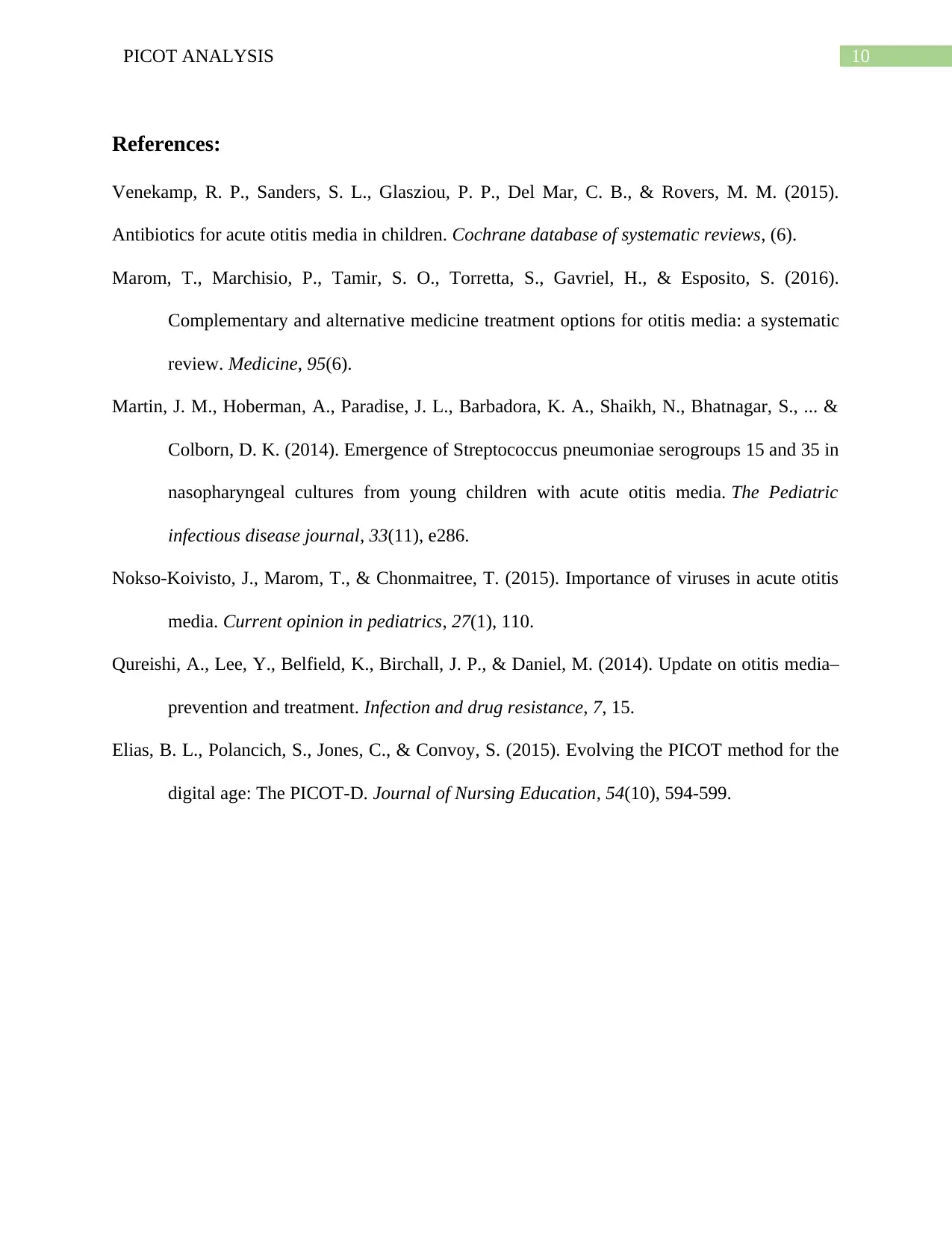
10PICOT ANALYSIS
References:
Venekamp, R. P., Sanders, S. L., Glasziou, P. P., Del Mar, C. B., & Rovers, M. M. (2015).
Antibiotics for acute otitis media in children. Cochrane database of systematic reviews, (6).
Marom, T., Marchisio, P., Tamir, S. O., Torretta, S., Gavriel, H., & Esposito, S. (2016).
Complementary and alternative medicine treatment options for otitis media: a systematic
review. Medicine, 95(6).
Martin, J. M., Hoberman, A., Paradise, J. L., Barbadora, K. A., Shaikh, N., Bhatnagar, S., ... &
Colborn, D. K. (2014). Emergence of Streptococcus pneumoniae serogroups 15 and 35 in
nasopharyngeal cultures from young children with acute otitis media. The Pediatric
infectious disease journal, 33(11), e286.
Nokso-Koivisto, J., Marom, T., & Chonmaitree, T. (2015). Importance of viruses in acute otitis
media. Current opinion in pediatrics, 27(1), 110.
Qureishi, A., Lee, Y., Belfield, K., Birchall, J. P., & Daniel, M. (2014). Update on otitis media–
prevention and treatment. Infection and drug resistance, 7, 15.
Elias, B. L., Polancich, S., Jones, C., & Convoy, S. (2015). Evolving the PICOT method for the
digital age: The PICOT-D. Journal of Nursing Education, 54(10), 594-599.
References:
Venekamp, R. P., Sanders, S. L., Glasziou, P. P., Del Mar, C. B., & Rovers, M. M. (2015).
Antibiotics for acute otitis media in children. Cochrane database of systematic reviews, (6).
Marom, T., Marchisio, P., Tamir, S. O., Torretta, S., Gavriel, H., & Esposito, S. (2016).
Complementary and alternative medicine treatment options for otitis media: a systematic
review. Medicine, 95(6).
Martin, J. M., Hoberman, A., Paradise, J. L., Barbadora, K. A., Shaikh, N., Bhatnagar, S., ... &
Colborn, D. K. (2014). Emergence of Streptococcus pneumoniae serogroups 15 and 35 in
nasopharyngeal cultures from young children with acute otitis media. The Pediatric
infectious disease journal, 33(11), e286.
Nokso-Koivisto, J., Marom, T., & Chonmaitree, T. (2015). Importance of viruses in acute otitis
media. Current opinion in pediatrics, 27(1), 110.
Qureishi, A., Lee, Y., Belfield, K., Birchall, J. P., & Daniel, M. (2014). Update on otitis media–
prevention and treatment. Infection and drug resistance, 7, 15.
Elias, B. L., Polancich, S., Jones, C., & Convoy, S. (2015). Evolving the PICOT method for the
digital age: The PICOT-D. Journal of Nursing Education, 54(10), 594-599.
1 out of 11
Related Documents
Your All-in-One AI-Powered Toolkit for Academic Success.
+13062052269
info@desklib.com
Available 24*7 on WhatsApp / Email
![[object Object]](/_next/static/media/star-bottom.7253800d.svg)
Unlock your academic potential
Copyright © 2020–2025 A2Z Services. All Rights Reserved. Developed and managed by ZUCOL.





